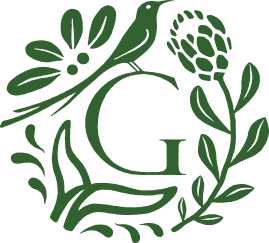Lachenalia lutzeyeri
Hyacinthaceae Family
This species was first found on the upper slopes of Witkransberg by Heiner Lutzeyer in 2004 and named in honour of his find and contribution to nature conservation in the southern Cape, L. lutzeyeri. This species has an unusually deep-seated, globose white bulb with membranous, dark brown outer tunics and many roots. It has one or two leaves which are narrow and yellowish green or pale to deep maroon. The large amount of flowers are oblong and yellowish cream with dark green or brown gobbosities with a fairly strong soapy-sweet scent. The flower stalk is usually green and unmarked or yellowish green and heavily marked with tiny maroon speckles or small to large maroon blotches. The Lachenalia lutzeyeri has remained largely undetected due to its extremely erratic flowering and dependance on summer or early autumn fires. It is also one of only 3 species of this genus known to be entirely dependant on fire to flower. The species grows in direct sunlight in open areas or between Table Mountain Sandstone boulders on a number of ridges on the Reserve.
Take a step towards the wonders of nature!
Make Enquiry
Need help crafting a unique itinerary for your stay? Or, do you simply have a question we haven’t answered? Get in touch with us and we’ll get back to you right away.
Unique Fynbos Species of Grootbos (Part 2)
Welcome to part two of our in-depth look at the unique fynbos of Grootbos Private Nature Reserve.
As mentioned in part one, the impressive list of plant species found on the Reserve and the surrounding area is a culmination of ideal natural conditions. The Reserve is located in the heart of the Cape Floral Kingdom as well as forming part of the adjacent Walker Bay Conservancy. The Cape Floral Kingdom in itself covers a mere 91000km², but is home to an estimated 9000 flowering plant species of which 70% is restricted to this specific area. Fynbos contributes to roughly 80% of the vegetation of this region, although renosterveld, karroid shrubland, thicket and forests can also be found here.

With so many different vegetation types and rare species found in the area, it is extremely important that the area’s plant species are protected and this is exactly one of Grootbos’ main focus areas. To ensure and encourage this, Grootbos has a number of initiatives which ensure the education of the community about sustainability like the various projects of the Grootbos Foundation as well as the get-your-hands-dirty Future Trees Project where guests can add onto the ancient Milkwood forests by planting trees themselves. These and other planned initiatives will ensure the protection of these rare, endemic species for generations to come.
Among these are the 6 unique fynbos species of Grootbos. We continue now with our look at the remaining four species discovered on Grootbos:


Pterygodium vermiferum
Orchidaceae Family
First recorded in 2003 by Heiner Lutzeyer, the only 3 known populations of this species covers a mere 5.5 x 3km area, the majority of which is protected by the Grootbos Reserve. Pterygodium vermiferum is named after the curious worm-like outgrowths of the rostellum (the sterile organ which separates the male and female parts of the flowers to prevent self-pollination). This species is identified as a small, slender tuberous geophyte with a highly specialised enlarged lip appendage that secretes oil. The oil aids in pollination by attraction oil-collecting female bees of the Rediviva genus. Along with this specialised adaptation, the species has mastered self-pollination. Within a day of flowering, the pollen grains fall from the pollen-forming sacs and adhere to the closest lobes of the female stigma within the same flower. Within 3 days the flowers wither and the plant releases copious amounts of seeds. This species also flowers most profusely after fire.
Capnophyllum lutzeyeri
Apiaceae Family
The Capnophyllum lutzeyeri has only ever been recorded on the Grootbos Reserve. The species was first spotted in 2006 following the fire and seems to favour acidic soils. In follow-up surveys no plants were found suggesting that it is a short-lived, fire-induced species. The plant is identified as a sprawling, annual herb with white flowers in separate flower clusters. It branches from the base with finely divided, soft leaves that splits into oval leaflets. This species carries unisexual flowers and smooth, elliptical fruits with winged margins.


Dasispermum grandicarpum
Apiaceae Family
This species has only been found on Grootbos where it was first collected by Heiner Lutzeyer in 2007 in fynbos vegetation that had burnt the previous year. No other plants could be found in subsequent searches which suggests that this species is also a short-lived species which germinates, flowers and dies in the first year following fire. The plant is identified as an erect, annual herb with typical herbaceous stems which are not branched at the base, but may divide higher up with characteristic purple blotches. The leaves are 2-pinnate with the ultimate leaflets being linear-oblong. The plant also produces fruits slightly longer than 3.9mm.
These are the unique fynbos species of Grootbos. For your chance to view and learn more about these incredible species and how they fit into the intricate ecosystem sculpted through the ages, book your stay with us today! Every Grootbos Stay includes a 4x4 Flower Safari and Horse Riding experience as well as the chance to follow the walking and hiking trails through the Reserve to get up close and personal to the fascinating world of fynbos found on Grootbos Private Nature Reserve.

We hope that you enjoyed this journey with us. Remember to keep an eye on our blog for more insightful journeys from Grootbos and in case you missed it, have a look at the Unique Fynbos Species of Grootbos (Part 1).
Grootbos Foundation and global recognition
Grootbos is a world leader in sustainable tourism and has been awarded some of the highest international accolades possible, making us one of only a handful of lodges to achieve this.





